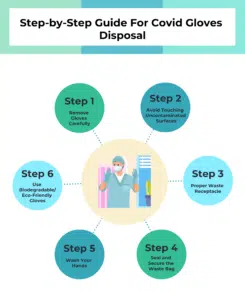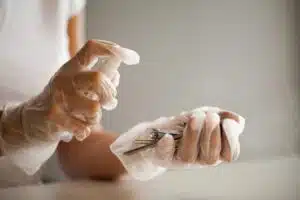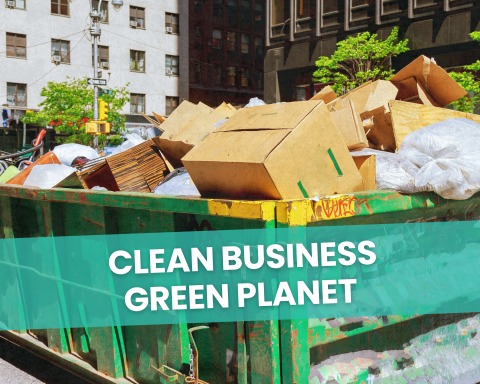Step-by-Step Guide: How to Properly Dispose of Used Covid Gloves
Stuck with used Covid gloves and worried about where they end up? You’re tackling a problem that’s slipped under the radar for too many.

We’ve all been there, at the end of a grocery run or a day out, peeling off those gloves and facing the bin. It’s not just about getting rid of them, it’s the unease of adding to our growing waste challenge.
What’s the real impact of tossing them the wrong way, and how can we do better?
Let’s unpack this, step by simple step, guiding you through the responsible disposal of Covid gloves.
Table of Contents
Why Tossing Your Gloves the Right Way is a Big Deal
Throwing gloves away the wrong way is risky business, for the planet and for us. When gloves aren’t disposed of properly, they can hurt wildlife, mess with ecosystems, and even end up in our oceans.
And let’s not forget, during COVID-19, we all used a ton of these gloves. The result? A big spike in waste that’s hard to ignore.
COVID-19 really changed the game. Before, we might not have thought twice when using disposable gloves for a quick clean-up or a trip to the store.
Now, there’s a sea of gloves being used and tossed every day. This surge has shown us just how much waste we can generate when we’re not careful.
But here’s where we come in, every single one of us, businesses too.
We’ve got a chance to turn things around. By getting smart about how we throw away our gloves, we can cut down on waste and do our part for the environment.
So, what’s the deal with all these gloves? Can’t we do better? Yes, we can.
know the smart way to toss them out and think about the bigger picture. keeping our world clean, not just our hands. Let’s figure this out together, step by step.
Step 1: Remove Gloves Carefully
Taking off your gloves the right way is key to keeping things clean and safe. Here’s a simple guide to do it without spreading germs:
- Pinch and Hold: Start by pinching the outside of one glove near your wrist. Be careful not to touch your skin.
- Pull Down: Carefully pull the glove away from your hand, turning it inside out as you go. Hold the removed glove in your gloved hand.
- Slide: With your free hand, slide a finger under the wrist of the remaining glove. Make sure it’s the inside part that hasn’t touched anything else.
- Peel Off: Gently peel it off from your hand, wrapping the first glove inside it. This way, the germs from the outside are kept inside the now balled-up gloves.
- Dispose Wisely: Drop the gloves into a trash bin. Don’t toss them into recycling.
- Wash Up: Always wash your hands after removing gloves to remove any germs that might have gotten through.
This method, often called the “beak method,” minimizes your contact with the contaminated parts of the gloves. It’s simple, straightforward, and keeps everyone a bit safer.
Step 2: Avoid Touching Uncontaminated Surfaces
When wearing gloves, it’s easy to forget they can transfer germs to clean surfaces. Here’s how to be mindful:
- Mindful Movement: Remember, every surface your gloves touch could transfer germs. Plan your actions to touch only what’s necessary.
- Creative Alternatives: Use objects like a pen for keypad buttons or an elbow for light switches to keep clean surfaces uncontaminated.
- Designated Hand Strategy: Assign one hand for potentially dirty tasks and the other for handling personal items like your phone. This minimizes cross-contamination.
- Awareness is Key: It’s not just about what we touch, but how we touch. Being conscious of our glove’s contact points can significantly reduce unnecessary spread.
Experts don’t often discuss these everyday strategies, but they’re crucial in maintaining a clean and safe environment.
This approach requires a bit of planning and awareness but makes a big difference in minimizing germ transfer from gloves to clean spaces.
Step 3: Dispose of Gloves in a Proper Waste Receptacle
When it’s time to dispose of your gloves, knowing where they should go is crucial. Not all gloves end up in the same place. In most cases, used disposable gloves from everyday activities are considered general waste.
This means they can go into your regular trash bin. However, the setting can change things.
For example, gloves used in healthcare settings or in contact with hazardous materials might need special treatment as hazardous waste.
The trick is to understand the local guidelines. Different areas have different rules about what to do with gloves, especially if they’re potentially contaminated. Generally, for the public, popping them into a regular bin is okay.
But it’s always good to double-check, especially if you’re dealing with more than just everyday germs. Proper disposal helps keep everyone safe and ensures that we’re not causing harm to our environment or putting others at risk.
For more easy-to-adopt disposal solutions and to learn how your used gloves can contribute positively, check out beneficial reuse services.
Step 4: Seal and Secure the Waste Bag
Securing your waste bag after disposing of used gloves requires attention to detail. Waste Advantage Magazine suggests an extra precaution for even safer disposal: bagging used gloves before placing them into the trash.
Here’s what you need to keep in mind:
Tie Tightly
Always ensure the bag’s top is twisted and knotted securely. For example, after filling a bag with used gloves from a day’s cleaning, twist the open end and make a secure knot. This prevents any contents from spilling out, should the bag be tipped over or breached.
Double Bag if Necessary
In situations where gloves have been used in a medical setting or have come into contact with hazardous materials, double-bagging is a wise precaution.
For instance, placing the first bag of used gloves into a second bag before tying it up can provide an added layer of protection against leaks or tears. This practice is highly recommended for environments dealing with a high volume of waste or particularly risky waste materials.
Eco-friendly Bags
Opting for eco-friendly waste bags, such as those made from biodegradable materials, is a recommendation close to our heart.
These bags, unlike traditional plastic ones, will break down more easily in a landfill, reducing long-term environmental impact.
For personal use at home, switching to bags certified as compostable for garden waste or certain types of household waste can make a significant difference in your environmental footprint.
Step 5: Wash Your Hands Thoroughly
After removing your gloves, washing your hands is a step you just can’t skip. Here’s how to ensure your hands are clean and safe:
- Warm Water and Soap: Start with warm water and enough soap to cover both hands. Rub your hands together, making sure to lather all surfaces – the backs of your hands, between your fingers, and under your nails. Do this for at least 20 seconds.
- Rinse and Dry: Rinse your hands well under clean, running water. Dry them using a clean towel or air dry. Using a towel, turn off the tap to avoid recontaminating your hands.
When soap and water aren’t on hand, hand sanitizers are a good backup. Brands like Purell, Germ-X, and Dettol offer sanitizers with at least 60% alcohol.
This concentration is key to effectively killing germs. Squirt a bit into one palm and rub your hands together until they’re dry, covering all the same areas you would with soap and water.
Remember, sanitizer is a solid option when you’re on the go, but soap and water are best for thoroughly cleaning your hands.
Making handwashing a habit after removing gloves, or when you come home from being out, is a simple yet powerful way to keep yourself and others safe.
Step 6: Consider Using Biodegradable or Eco-Friendly Gloves
When we think about gloves that are kinder to our planet, there are some cool options not everyone talks about:
Plant-Based Nitrile Gloves
Traditional nitrile gloves are known for their strength and durability, but their eco-friendly counterparts are made from renewable resources, such as plants.
These gloves decompose more quickly in the environment compared to their synthetic nitrile relatives, reducing long-term waste.
TPE (Thermoplastic Elastomer) Gloves
TPE gloves are a recyclable alternative to traditional disposable gloves. They offer a similar level of protection and flexibility as other non-biodegradable gloves.
The key advantage of TPE gloves is their ability to be processed through recycling facilities, reducing the accumulation of waste in landfills.
Sustainably Sourced Latex Gloves
These gloves are made from natural rubber harvested from rubber trees grown in sustainably managed plantations.
The focus on sustainable farming practices helps prevent deforestation and supports the livelihood of farmers.
Natural rubber latex gloves are biodegradable, breaking down naturally over time without harming the environment.
PHA (Polyhydroxyalkanoates) Gloves
Produced by microbial fermentation of sugar or lipids, PHA gloves are fully biodegradable and compostable.
Unlike traditional plastics, PHA polymers break down completely into water, carbon dioxide, and organic matter when composted, leaving no toxic residue. This makes PHA gloves an ideal choice for reducing plastic pollution.
Each of these options offers a way to protect both human health and the environment.
Conclusion: Taking Responsibility for Safe and Eco-Friendly Disposal
Proper disposal of gloves isn’t just a tiny detail, it’s a big part of keeping our planet cleaner. We’ve seen how tossing gloves the right way helps cut down on waste and protect our environment.
Remember, every glove counts. And when we choose eco-friendly options, like biodegradable gloves, we’re making an even bigger impact.
Happen Ventures takes this a step further by turning glove disposal into an opportunity for beneficial reuse, transforming waste into resources for communities.
Taking action, big or small, to contribute to a healthier planet should be our goal. Let’s keep this commitment in mind every time we peel off those gloves.













